This is the second in a series of posts on the education white paper. The other parts can be found here.
It’s well-known that a greater share of secondary schools have become academies to date than have primaries.
Coupled with the fact that there are lots more primary schools, this means that the bulk of schools that’ll have to convert to academy status if the government is able to implement its policy of a fully academised system by 2022 are primaries.
It’s helpful to look at this in pure number terms, in order to get a proper sense of scale.
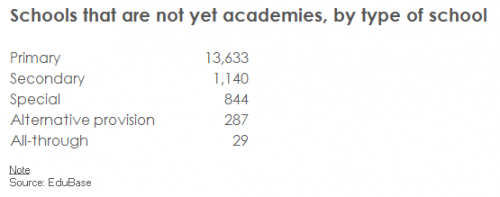
So, there will be a little less than 12 primary schools converting for every secondary school. The total number of special schools, all-through schools and alternative provision settings that will have to convert is similar to the secondaries figure.
Current structure
We saw in the first of these posts that the single most common, or modal, size of academy trust is of one school on its own.
Looked at another way, though – and offering a useful reminder that two statistics that sound contradictory can both be true – some way more than half of academies – 62 per cent – are part of an academy chain with at least one other school[1][2].
So-called multi-academy trusts (MATs) are far from homogeneous. As the figure below shows, some MATs are made up solely of primary schools. Others – less commonly – are made up only of secondaries, or special schools, or alternative provision.
And a larger group – highlighted – contain two or more different phases of school.

The future
As well as setting out its intention to turn every school into an academy, the government’s white paper set out its view that schools should generally be part of a MAT [pdf].
Regardless of the government’s preferences, there might well be other factors that lead to the MAT model becoming an ever bigger part of the picture too – the significant budgetary pressure that schools are under, for example.
The upshot of this, if it does happen, will be a change in the mix of multi-academy trusts.
As we saw before, there are vastly more primary schools than secondaries that will have to become part of the academies world – that 12-to-one ratio.
So we can expect a lot more primary-only MATs. And, whether as part of newly established trusts, or expansions of existing MATs, there will be an enormous shift in the ratio of primaries-to-secondaries in those MATs that cover both phases[3].
Among existing MATs with both primary and secondary schools, there are very few with ratios in the region of 12 or more primaries per secondary, as the below figure shows[4].

Does this matter?
Department for Education (DfE) research suggests it might. A May 2014 analysis produced by the DfE, based on research involving 88 MATs, states that chains dominated by primaries were generally less high-performing, and had weaker financial management (slide 19).
Department for Education chart on the performance of primary-dominated academy trusts[5]
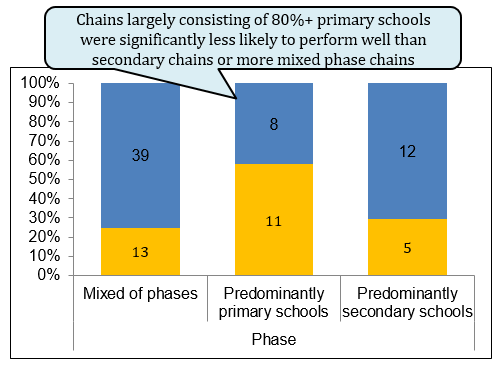
Now it’s worth keeping a few things in mind when trying to draw conclusions from this.
Firstly, there exist some high-performing MATs made up mainly of primary schools, so clearly being less likely to perform well isn’t an inevitable consequence of a trust being very heavily weighted towards primaries.
There are also only a relatively small group of trusts on which these conclusions have been drawn – while definitely worthy of consideration, it would be rash to place too much importance on this research. It’s also two years old – two years in which the number of primary academies has grown, hopefully meaning that lessons will have been learnt both by the DfE and by the trusts of which these schools are a part.
The research also notes that primary-dominated trusts’ results moved around more than those of trusts with weighted more towards secondaries – smaller cohorts leading to greater variability in test results from year to year.
And specifically on financial management, many MATs would make the point that they can offer support and specialist skills that a small primary school might not have access to on its own.
Regardless, one conclusion that can be drawn is that the structure of a MAT can have an important bearing on how it operates, and how performance of the trust appears overall.
Hat-tip to an Alan Stinchcombe for putting in the freedom of information request through which the DfE research was released, and to education consultant Robert Hill for bringing it to wider attention.
1. All analysis done based on a 9th April cut of EduBase data.‘Academies’ includes all types of academies – sponsored academies, converter academies, free schools, studio schools and university technical colleges. Nurseries and post-16 institutions do not feature in the analysis.1. A total of 102 schools feature in EduBase without trust or sponsor information. While most of these are likely to be in single academy trusts, they have been excluded from this part of our analysis.
2. A loose definition of trust membership has been adopted. Further details can be found in the footnotes to the first post in this series.
3. As mentioned at the top of this post, there are also roughly the same number of special schools, all-through schools and alternative provision settings that have yet to become academies as there are secondaries – not a trivial number. The DfE research discussed in the rest of this post focusses on primaries and secondaries, though, so the consideration of ratios in the rest of this piece is limited to these two groups also.
4. In part this is because the majority of MATs are made up of fewer than 13 schools, so they could never have such a ratio. But even among MATs bigger than this, the ratio of secondaries to primaries can be much lower. Greenwood Dale Foundation Trust, for example, has a primary-to-secondary ratio of 2.5; 20 primaries and eight secondaries, together with one all-through school and a special school.
5. ‘High performance’ in the DfE’s research is defined based on a combination of: KS2/KS4 results, the volatility and trend of these results, and Ofsted results. Details can be found on slide six of the presentation.

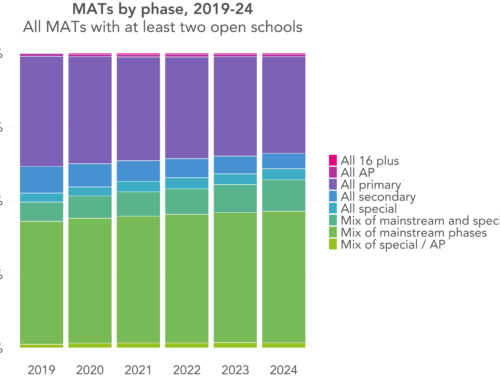

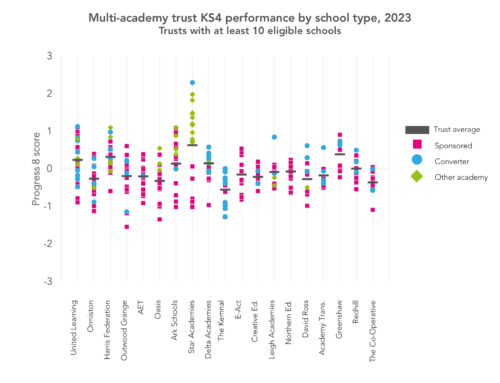
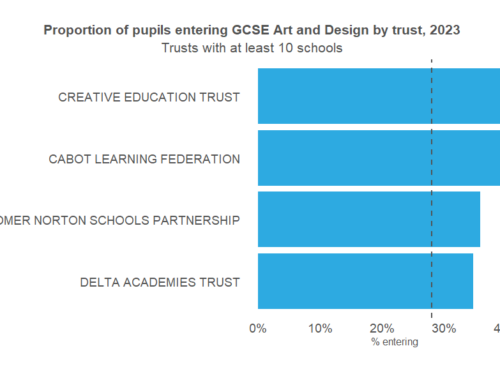
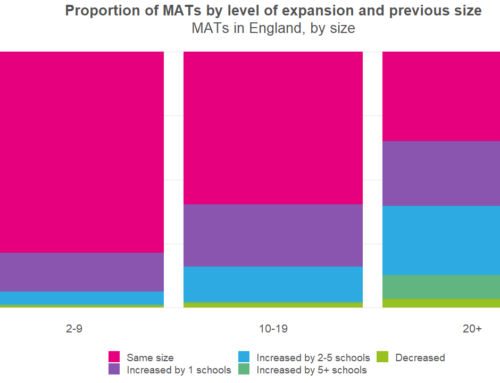
Leave A Comment